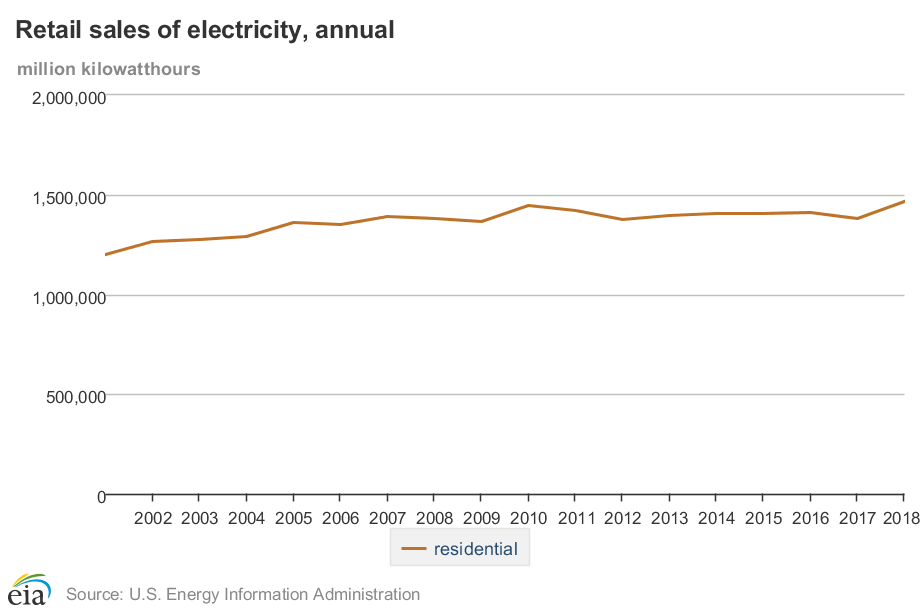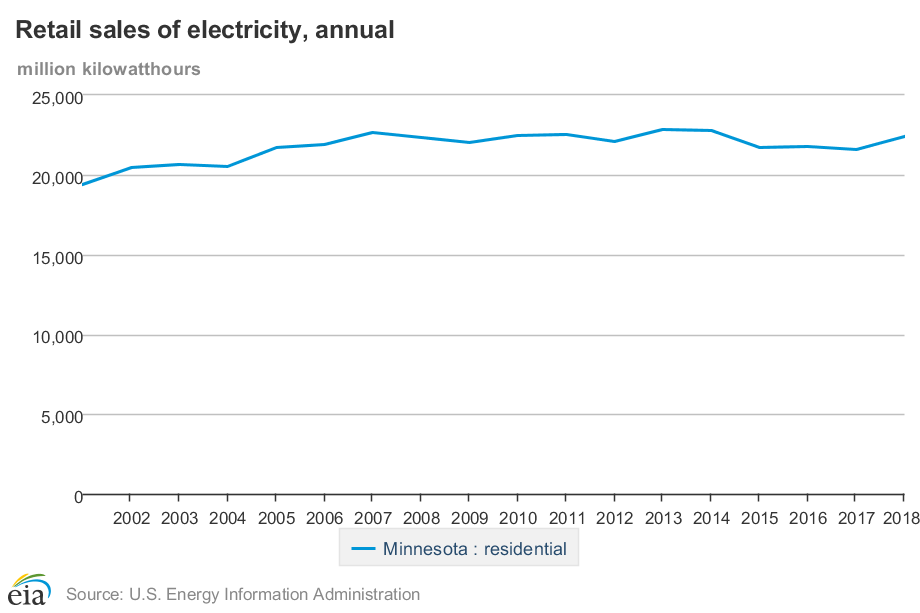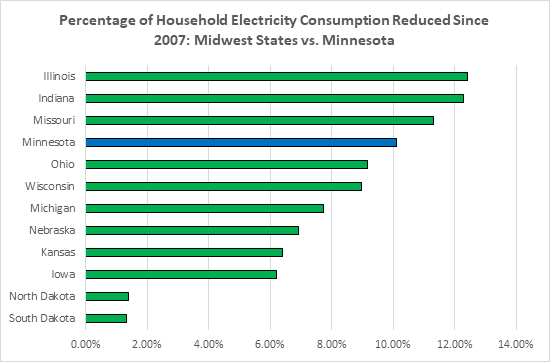Fresh Energy Is Still Intentionally Misleading Minnesotans on Energy Issues: Part Three – Energy Efficiency in Minnesota Isn’t So Spectacular
Fresh Energy, a renewable energy advocacy organization, continues to mislead Minnesotan’s on energy issues — and it appears they don’t appreciate our work explaining how wind and solar are driving up the cost of electricity in our state.
In their latest critique of American Experiment, Fresh Energy made multiple attempts to inaccurately portray our organization as misunderstanding how electric rates work, while arguing that wind and solar are the cheapest sources in our state, and boon to job creation.
Each of these claims is demonstrably false.
The article below is the third in a series of articles that will thoroughly explain how Fresh Energy continues to mislead Minnesotan’s on the cost of electricity in our state.
Energy Efficiency in Minnesota Isn’t Spectacular
Now that we’ve broken down why Minnesota uses less electricity than other states (see Part 2 in this series), let’s discuss how energy conservation efforts in our state aren’t as spectacular as you may think.
Let’s make something clear – we’re not saying energy efficiency is bad, nor are we saying Minnesotan’s shouldn’t strive for ways to reduce their energy consumption.
Energy conservation is a good thing, if it actually saves you money.
What we mean by “isn’t spectacular” is that energy efficiency isn’t something only taking place in Minnesota as a result of some amazing public policy in our state, as some organizations like Fresh Energy would like you to believe.
As Fresh Energy wrote in a critique of American Experiment:
“The Next Generation Energy Act not only included the Renewable Energy Standard, it also spurred energy efficiency and conservation. Energy efficiency helps customers use less energy, and save money, even as more appliances and electronics enter our homes and businesses… [P]er capita electricity sales in Minnesota increased 1.2 percent per year on average between 1990 and 2007. Since the Next Generation Energy Act, however, electricity sales have actually declined by 1 percent per year. This is great news for consumers and utilities—who have fewer power plants to pay for—and for the planet, as all of those emissions are avoided.”
The problem with Fresh Energy’s logic is that Minnesota ratepayers are paying to maintain more power plants, not fewer (discussed in a later entry in this series), and Fresh Energy made it seem like energy efficiency in Minnesota only occurred because of the state’s energy efficiency goals found in the Next Generation Energy Act (NGEA), signed into law in 2007 by then-governor Tim Pawlenty.
But Fresh Energy didn’t mention an important fact: electricity consumption has been essentially flat across the entire country since 2005, as shown in the graph below from the U.S. Energy Information Administration (EIA).
Below this graph, you will see another graph from EIA showing Minnesota electricity sales over the same time period. With the exception of a brief period where electricity sales increased in Minnesota during 2013 and 2014, the two graphs are largely identical.


And that’s because increasing energy efficiency isn’t exclusive to Minnesota or spurred solely by our state’s public policies encouraging or mandating energy conservation. In fact, falling energy consumption has been a nation-wide phenomenon, regardless of whether energy efficiency goals are present, or not.
The graph below shows the percentage of electricity reduced from 2007 to 2017 for every state in the Midwest. As you can see, every state used less electricity in 2017 than it did in 2007. In fact, sometimes states without any energy efficiency laws sometimes decreased electricity consumption by higher percentages than Minnesota.

It’s also interesting to note that Indiana repealed its energy efficiency standards in 2014, but still managed to reduce its electricity consumption more than Minnesota.
But Fresh Energy, in an effort to reassure their readers that the NGEA spurred some unique energy efficiency phenomenon in our state, disingenuously compared household electricity consumption in Minnesota to North and South Dakota, which, as the chart above shows, are the two states in the Midwest that reduced their electricity consumption the least.
As Fresh Energy stated:
“As the chart shows [attached below], electricity usage tracked very closely in the three states [Minnesota, North Dakota, and South Dakota] before 2007, but thanks to Minnesota’s investments in energy efficiency, electricity usage per capita has declined consistently over the past decade, while our neighbors’ usage has continued to increase.”

As you can see, Fresh Energy cherry-picked the two states with the least reduction in electricity consumption per household. Why did Fresh Energy do this? We can’t say for sure, but we’d wager they did it because it’s the only comparison that would justify their incorrect implication that the NGEA is solely responsible for energy efficiency in Minnesota.
In fact, there is a good case to be made that Minnesota would have reduced its electricity consumption regardless of whether the NGEA was ever signed into law.
For instance, Alabama, Alaska, Georgia, Idaho, Indiana, Mississippi, Nebraska, South Carolina, and West Virginia don’t have any energy efficiency goals on the books, yet households in these states still saw a reduction in monthly electricity consumption by at least 7 percent from 2007 to 2017.
In fact, West Virginia households managed to reduce consumption by over 20 percent since 2007 without any energy efficiency mandates, while Minnesota households, on the other hand, reduced consumption by only 10 percent.

As you can see from the graph above, energy conservation has been happening in our state, but it certainly isn’t exclusive to our state, or even more effective.
And because households across the country are reducing their electricity consumption in similar or greater amounts than Minnesota residents, regardless of energy efficiency laws, it’s rather ridiculous to insinuate that “good public policy” encouraging energy efficiency in our state is solely responsible for the decrease in electricity usage, as Fresh Energy falsely repeats time and again.
Furthermore, energy efficiency in Minnesota should have been a good thing for consumers, but it wasn’t because electric utility companies simply raised their prices to make up for selling less electricity.
This, coupled with enormous investments in renewable energy, have caused monthly electric bills in Minnesota to increase by 8 percent since 2007, in inflation-adjusted dollars, even though electricity consumers used 10 percent less electricity than they did in 2007.
This means that Minnesota ratepayers are now paying more money for less electricity than they did before the NGEA passed. How’s that for unspectacular results?